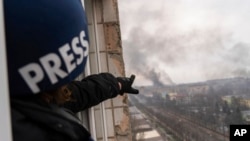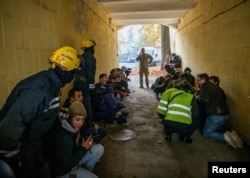As Ukraine continues its counteroffensive effort to push back Russian forces in the country’s southeast, local and international media are getting close to the frontlines. Doing so has brought an increase in injuries, though, with at least three wounded during the latter half of July.
The recent injuries of journalists covering Ukraine military action in the Donetsk region have prompted safety warnings from media watchdogs.
“This is a conflict. And we saw very early on journalists being killed, journalists being injured. We’re still seeing this,” said Elisabet Cantenys, executive director of the A Culture of Safety, or ACOS, Alliance, which supports journalist safety. “Of course, very recently we’ve seen an increase in injuries.”
On July 24, Dylan Collins, an American video journalist working with the French outlet Agence France-Presse, was injured in a drone attack while reporting at a Ukrainian artillery position near the frontline city of Bakhmut in the Donetsk region.
Two days earlier on July 22, Ievgen Shylko, a camera operator with German public broadcaster Deutsche Welle, was seriously injured by a Russian shelling attack. Shylko, who is also a regular contributor to Voice of America, was reporting on a Ukrainian army training ground near the city of Druzhkivka in the Donetsk region when he was hit by shrapnel from a Russian cluster munition.
On July 19, Ukrainian journalist Yuliya Kiriyenko suffered a concussion from Russian shelling while reporting in the Donetsk region.
Cantenys, who is based in Barcelona, said it’s normal for the number of journalist injuries and fatalities to ebb and flow during conflicts.
“There are peaks, and we have three cases in a row,” she told VOA. “There have been times where we’ve seen more violence and we’ve seen journalists getting injured or killed. And then we’ve seen periods where there’s been a little bit more of a break.”
“This is the nature of this conflict, and we will continue to see this,” Cantenys added.
In light of these three injuries, the press freedom group the Committee to Protect Journalists, or CPJ, called on Kyiv and Moscow to investigate the attacks and ensure reporters are not targeted while covering the war.
“Journalists reporting in Ukraine are vital eyewitnesses who have been documenting Russia’s full-scale invasion of the country for almost a year and a half now,” Gulnoza Said, CPJ’s Europe and Central Asia program coordinator, said in a statement.
At least 15 journalists have been killed while on assignment to cover the war, according to CPJ data. Many more have been injured.
“Russian and Ukrainian authorities should investigate the recent attacks that seriously injured Ievgen Shylko and Dylan Collins and ensure that members of the press covering the war are protected under international humanitarian law,” Said added.
Russia and Ukraine’s Washington embassies did not immediately reply to VOA’s emails requesting comment.
Both Collins and Shylko suffered shrapnel injuries. Collins was evacuated to a local hospital, and Shylko was transported to a hospital in Kyiv after receiving initial treatment at a hospital in the city of Dnipro.
Collins’ injury comes a few months after fellow AFP video journalist Arman Soldin was killed in May in a rocket attack near the Ukrainian city of Chasiv Yar.
Russian state outlet RIA Novosti, meanwhile, reported that Rostislav Zhuravlyov, a military correspondent for the state-owned outlet, was killed by Ukrainian shelling on July 22 near the village of Pyatikhatki in the Zaporozhye region.
The war in Ukraine has underscored the particular safety risks that freelance reporters face compared to staff journalists when reporting from conflict zones, according to Cantenys. Freelancers often don’t have the same access to insurance, safety equipment, safety training or general institutional support, she said.
“From the very beginning, one of our major concerns was to see an influx of journalists racing toward Ukraine without the equipment, without the experience, without the training, without the backing that a context of such violence requires,” Cantenys said.
Still, both freelancers and staff journalists are facing tremendous safety risks while reporting in Ukraine, Cantenys added.
“A bullet doesn’t distinguish whether you are a freelancer or not. Shellings — the same,” she said. “And rocket attacks don’t either.”








